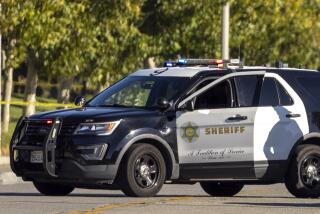Officer on Trial Testifies About Gang Politics Behind ’96 Incident
- Share via
Testifying for a second day in his own defense at the Rampart police corruption trial, Sgt. Brian Liddy described in painstaking detail how fleeing gang members ran into him and a partner with a pickup truck in a Los Feliz alley on a summer night four years ago.
Prosecutors have charged that Liddy and his partner, Officer Michael Buchanan, made up portions of their story about the truck and framed its driver for assault.
Repeatedly mangling the past tense--”some of the gang members have went”--Liddy gave the impression of an earnest workman sharing his expertise, which happened to center on mayhem.
He held jurors so rapt as he answered his attorney’s questions that, when it was finally her turn, prosecutor Anne Ingalls sought to undercut him by reminding jurors that he was a professional witness, trained to look them in the eye. “How many times have you testified?” she asked him. “In the hundreds, maybe into the thousands,” he replied.
Liddy was so calm and deliberate that it appeared he had no stake in how he was perceived. Actually, jurors hold his future in their hands. They must decide whether he and three colleagues from the Rampart anti-gang unit conspired to obstruct justice by planting evidence and lying on police reports and in court.
Liddy, a big man in a gray sport coat, purple shirt and patterned tie, explained intricacies of inter-gang politics so that jurors could better understand events that led up to the incident with the truck.
He said he and colleagues went to the alley only because Rafael Perez, the disgraced officer whose confessions sparked the scandal, reported that Temple Street gang members--including Anthony Adams, aka Stymie, who was wanted for a murder--were in the alley.
The murder had taken place the previous winter when a man nicknamed Lizard, a tax collector for the Mexican Mafia, was shot to death outside a McDonald’s restaurant.
Liddy explained that the Mexican Mafia is essentially a prison gang that tithes street-level gangsters south of Bakersfield and offers them umbrella protection from Northern California Latino gangs and other, non-Latino gangs when they are behind bars.
Detectives believed that Temple Streeters had defied the Mexican Mafia and that the Mexican Mafia had retaliated by putting out a “green light” on Temple Streeters, which meant they could be beaten up or worse in prison or jail, Liddy said. The Mexican Mafia further demanded that Temple Streeters either kill Stymie or pay several thousand dollars to “right the wrong” of Lizard’s death, he said.
As Liddy, Buchanan and other officers headed into the alley, Liddy said, two Temple Street gangsters tried to flee in a pickup truck, which ran into Buchanan, sending him sprawling across its hood and into its windshield. Liddy said the truck then veered toward him.
His gun was drawn, he said. But he didn’t shoot because he said he was worried about missing and hitting someone outside the truck. He said he was clipped by an open passenger-side door and landed on his behind. He then got back into his car and chased the truck’s driver, he said.
The driver crashed the truck into a curb and fled on foot.
The driver, Raul Rafael Munoz, testified previously that he had not tried to run down the officers but pleaded guilty to assaulting them because it was expedient. His conviction was overturned, largely on the strength of statements by Perez.
More to Read
Sign up for Essential California
The most important California stories and recommendations in your inbox every morning.
You may occasionally receive promotional content from the Los Angeles Times.









